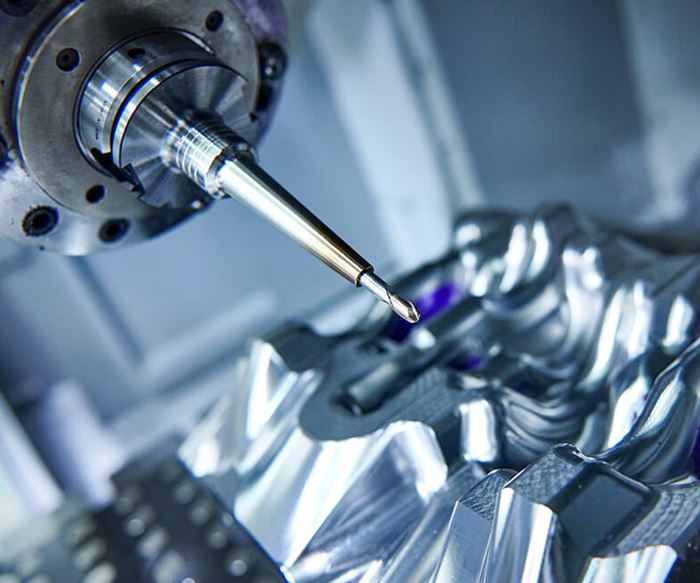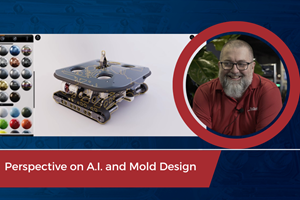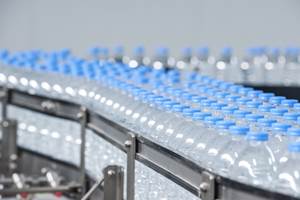Five-Axis Machining and Industry 4.0 Mold Shop Challenges
Harbour Results conducted an industry roundtable to better understand how the tool and die market views today’s machining technologies as well as the what the future holds for the industry.
To better understand how the tool and die market views today’s machining technologies as well as the what the future holds for the industry, Harbour Results conducted an industry roundtable at this year’s IMTS Conference held in Chicago in September.
The participants produce both molds and dies, range in shop size and utilize machine technologies across multiple manufacturers. And, across the board, each shop was at IMTS to discover new tools, technology, automation and software to improve costs, quality and efficiency while reducing risk and waste.
5-Axis Machining vs. 3 + 2 Machining
In simultaneous five-axis machining, the machine tool’s three linear axes (X, Y, and Z) and two rotational axes (A and B) all engage at the same time to perform complex processing on parts. With 3 + 2, the machine executes a 3-axis milling program with the workpiece locked into position via indexing the A/B axes.
A majority of the roundtable participants indicated that they are utilizing 3 + 2 machining because it is less complex for the programmers and can be utilized across more machines in their shop. However, most shops have 5-axis capabilities because of the benefits or, in some instances, it is the only process that can complete the job.
Although programming time may be reduced, the efficiencies are lost due to increased runtime, which is a huge barrier for any shop.
In addition to reducing set up time, participants noted the ability to minimize workpiece handling and increasing accuracy as benefits of five-axis machining. Regardless of the benefits, five-axis continuous cutting has many real and perceived disadvantages including the number of people trained on how to program in this manner (even though it is easier for some applications). Others indicate that the rotational drive/CNC controller on their machines can’t keep up with linear drives resulting in continuous five-axis program cut times being much longer than 3+2.
So, although programming time may be reduced, the efficiencies are lost due to increased runtime, which is a huge barrier for any shop. However, participants noted that as part design becomes increasingly complex the need for this technology will grow. Today, it is already a no-brainer for high precision surface requirements such as optics for automotive lighting or certain medical device applications. From what we learned, this topic warranted further investigation, and we plan to deep dive factors such as CAM, machine and cutter advancements that could maximize continuous five-axis machining.
Industry 4.0 – Myth or Reality
Across the board, roundtable participants are not fully leveraging the technology behind Industry 4.0 with some considering it a buzzword. Additionally, although there are some third parties that have Industry 4.0 products with their specific applications, there are very few, if any, that are providing facility-wide Industry 4.0 solutions. The average tool and die shop doesn’t have the capacity or the skill set to successfully integrate the needed upgrades – controllers, I/T infrastructure, third-party software, etc., to fully automate their shop.
The group did recognize that tool shops need to be looking at building a foundation that can integrate and succeed in an automated environment in the future. The primary Industry 4.0 areas in which shops are interested in today are machine monitoring, live scheduling, and real-time updates.
Most shops are utilizing some form of machine monitoring system whether it is homegrown or provided by a third party. Data currently being collected, includes machine uptime, machining hours by the job, spindle time, and machine time versus labor hours. Unfortunately, all too often, shops are not effectively utilizing the data and information to make decisions that can improve shop performance.
A successful implementation of Industry 4.0 for tool shops is to pick a couple of key technology elements and make them actionable.
It is important to note that machine monitoring can be the first step shops can take in adopting Industry 4.0. If a shop integrates its monitoring tool fully (gathers and utilizes data in real time to revise and update scheduling and feeds the ERP system), they are on the path to future shop automation.
A successful implementation for tool shops is to pick a couple of key technology elements and make them actionable. Once they have that mastered, they can then layer on more technology to continue to build towards remote and predictive service solutions that companies like Makino and United Grinding are integrating into their machines.
Although opinions may have been different among the roundtable participants and that most shops are slow to adopt new technology, one was clear; shops do not have a choice – automation and technology will play an important role in the future of the tool and die industry. Reports estimate that there will be a shortage of 2.4 million workers in manufacturing between now and 2028. The necessary number skilled-trades professionals do not exist, and companies know they must rely more on technology to run their business. This gap will accelerate the need for automation. Shops that wait too long to decide to invest in technology, training and the right people will be at a significant disadvantage.
Those that work together with their software, machine and automation partners to identify the right solutions and an implementation plan will come out as winners.
Meet the Contributors
James Ricci is CTO and Nick Stanziola is a senior consultant for Harbour Results Inc.
Related Content
VIDEO: Perspective on A.I. and Mold Design
Bill Genc of TopSolid shares his perspective on the benefits of and barriers to using artificial intelligence in mold design.
Read MoreProducts and Services for Multiple Moldmaking Needs
New year, new technology roundup! Featured here is a collection of product offerings, from profile milling cutters to industry-specific CAD/CAM software to innovative hot work tool steels.
Read MoreOEE Monitoring System Addresses Root Cause of Machine Downtime
Unique sensor and patent-pending algorithm of the Amper machine analytics system measures current draw to quickly and inexpensively inform manufacturers which machines are down and why.
Read MoreWhat is Driving Mold Lifecycle Management Digitalization?
OEMs are looking to partner with suppliers to share and track data across the supply chain for advanced intervention and process management.
Read MoreRead Next
Are You a Moldmaker Considering 3D Printing? Consider the 3D Printing Workshop at NPE2024
Presentations will cover 3D printing for mold tooling, material innovation, product development, bridge production and full-scale, high-volume additive manufacturing.
Read MoreReasons to Use Fiber Lasers for Mold Cleaning
Fiber lasers offer a simplicity, speed, control and portability, minimizing mold cleaning risks.
Read More

























